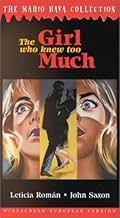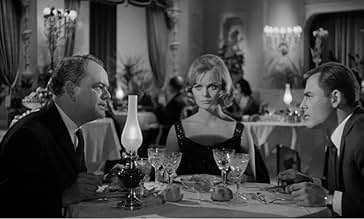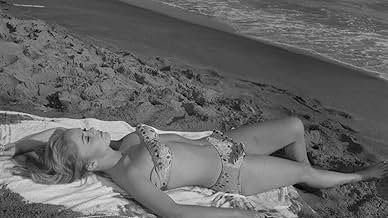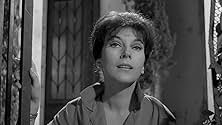PUNTUACIÓN EN IMDb
6,9/10
5,8 mil
TU PUNTUACIÓN
Una turista estadounidense amante de las novelas de misterio es testigo de un asesinato en Roma, y pronto su vida cambiará cuando ella y su pretendiente se vean involucrados en una serie de ... Leer todoUna turista estadounidense amante de las novelas de misterio es testigo de un asesinato en Roma, y pronto su vida cambiará cuando ella y su pretendiente se vean involucrados en una serie de asesinatos.Una turista estadounidense amante de las novelas de misterio es testigo de un asesinato en Roma, y pronto su vida cambiará cuando ella y su pretendiente se vean involucrados en una serie de asesinatos.
- Premios
- 1 premio y 1 nominación en total
Letícia Román
- Nora Davis
- (as Leticia Roman)
- …
Walter Williams
- Dr. Alessi
- (as Robert Buchanan)
Giovanni Di Benedetto
- Professor Torrani
- (as Gianni De Benedetto)
Franco Moruzzi
- Policeman
- (as Franco Morici)
Dante DiPaolo
- Andrea Landini
- (as Dante Di Paolo)
Mario Bava
- Uncle Augusto
- (sin acreditar)
Geoffrey Copleston
- Asylum employee
- (sin acreditar)
Adriana Facchetti
- Woman in Sguattera Restaurant
- (sin acreditar)
Argumento
¿Sabías que...?
- CuriosidadesMario Bava was a big fan of Alfred Hitchcock, and Hitchcockian touches abound in the film, including a cameo by the director. In the scene where Letícia Román is in her bedroom at Ethel's home, the portrait on the wall with the eyes that keep following her is that of Mario Bava.
- PifiasWhen Nora answers the phone in the Torrani house, "hello" is heard before she speaks, even while the receiver is being lifted to her mouth.
- Citas
Nora Davis: [into the phone] Oh mother, murders don't just happen like that here.
- Versiones alternativasAIP released this as The Evil Eye, a recut version with material used just in some countries out of Italy.
- ConexionesFeatured in Mario Bava: Maestro of the Macabre (2000)
- Banda sonoraFurore
(Appears in the Italian version)
Sung by Adriano Celentano
Written and Composed by Adriano Celentano (as Adicel) and Paolo Vivarelli (as Vivarelli)
Published by Edizioni Nazionalmusic and Disco Jolly
Reseña destacada
The Girl Who Knew Too Much (1963)
Well, this is a classic worth watching for film buffs interested in the first giallo movie ever made (if we ignore the Hitchcock precedents). Giallo films are purposely simple and gory and filled with dramatic camera-work. In a sense they play off the style, one after another, becoming increasingly about the genre rather than movies that stand on their own. It's like slasher films these days, or maybe even zombie films, where you watch knowing what you're going to get, and that's exactly what you want.
Even the director, Mario Bava, admitted openly this was a silly film with great cinematography. That sums it up. He couldn't even remember the two leading actors. There is a bizarre, cheesy, low-budget thriller aspect to the whole enterprise that makes it fun in a campy way even if you aren't a giallo fan. But it's not good in a traditional sense.
Even the main premise is old as the hills--a serial killer is stabbing women in the back in alphabetical order by last name. This is oddly confused in the plot, because woman C was killed a decade before and we see the next woman killed before our eyes. But the heroine's last name begins with D, as if she is going to be next, and indeed she finds her picture in a file at the end suggesting she really is next in line. So what letter did the woman killed before our eyes have?
One of the weird aspects to the plot might explain this--the woman accidentally smokes a marijuana cigarette at the beginning of the movie, and we come to realize she might have dreamed the whole episode. Never mind there are other deaths and mishaps that seem rather real. And a handsome Italian doctor in love with her.
It's also weird in a funny way that the lead woman is an Italian actress playing an American visitor in Rome. Naturally her Italian is excellent. And the whole movie is centered around the Spanish Steps, which are often completely (completely) empty, not a person around. Adds to the surrealism. There are creaky horror film conventions like the shadowy man seen through the window, or the overdecorated house with creepy lights where the woman is staying, alone of course.
What's to recommend this? The photography. The noir influence (and the Roger Corman one, I suppose) is clear. And beautiful. Now if the story and acting made some modicum of sense we'd be set for a classic over-the-top scary movie. Yes, it's important as a giallo example, but don't overblow the result.
Well, this is a classic worth watching for film buffs interested in the first giallo movie ever made (if we ignore the Hitchcock precedents). Giallo films are purposely simple and gory and filled with dramatic camera-work. In a sense they play off the style, one after another, becoming increasingly about the genre rather than movies that stand on their own. It's like slasher films these days, or maybe even zombie films, where you watch knowing what you're going to get, and that's exactly what you want.
Even the director, Mario Bava, admitted openly this was a silly film with great cinematography. That sums it up. He couldn't even remember the two leading actors. There is a bizarre, cheesy, low-budget thriller aspect to the whole enterprise that makes it fun in a campy way even if you aren't a giallo fan. But it's not good in a traditional sense.
Even the main premise is old as the hills--a serial killer is stabbing women in the back in alphabetical order by last name. This is oddly confused in the plot, because woman C was killed a decade before and we see the next woman killed before our eyes. But the heroine's last name begins with D, as if she is going to be next, and indeed she finds her picture in a file at the end suggesting she really is next in line. So what letter did the woman killed before our eyes have?
One of the weird aspects to the plot might explain this--the woman accidentally smokes a marijuana cigarette at the beginning of the movie, and we come to realize she might have dreamed the whole episode. Never mind there are other deaths and mishaps that seem rather real. And a handsome Italian doctor in love with her.
It's also weird in a funny way that the lead woman is an Italian actress playing an American visitor in Rome. Naturally her Italian is excellent. And the whole movie is centered around the Spanish Steps, which are often completely (completely) empty, not a person around. Adds to the surrealism. There are creaky horror film conventions like the shadowy man seen through the window, or the overdecorated house with creepy lights where the woman is staying, alone of course.
What's to recommend this? The photography. The noir influence (and the Roger Corman one, I suppose) is clear. And beautiful. Now if the story and acting made some modicum of sense we'd be set for a classic over-the-top scary movie. Yes, it's important as a giallo example, but don't overblow the result.
- secondtake
- 19 mar 2013
- Enlace permanente
Selecciones populares
Inicia sesión para calificar y añadir a tu lista para recibir recomendaciones personalizadas
- How long is The Evil Eye?Con tecnología de Alexa
Detalles
- Duración1 hora 23 minutos
- Color
- Mezcla de sonido
- Relación de aspecto
- 1.66 : 1
Contribuir a esta página
Sugerir un cambio o añadir el contenido que falta

Principal laguna de datos
By what name was La muchacha que sabía demasiado (1963) officially released in India in English?
Responde




























